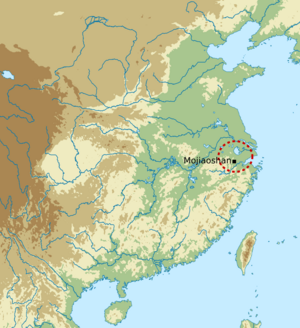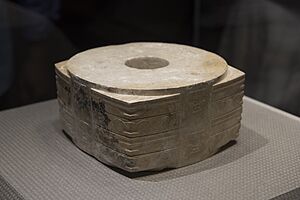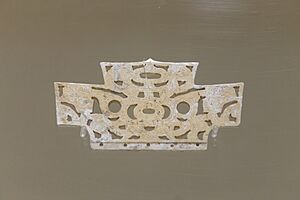Liangzhu culture facts for kids
 |
|||||||
| Geographical range | Jiangsu, Shanghai, & Zhejiang in China | ||||||
|---|---|---|---|---|---|---|---|
| Period | Neolithic China | ||||||
| Dates | 3300–2300 BC | ||||||
| Preceded by | Songze culture, Hemudu culture | ||||||
| Official name: Archaeological Ruins of Liangzhu City | |||||||
| Criteria: | Cultural: (iii), (iv) | ||||||
| Designated: | 2019 (43rd session) | ||||||
| Reference #: | 1592 | ||||||
| Region: | Eastern Asia | ||||||
| Chinese name | |||||||
| Chinese | 良渚文化 | ||||||
|
|||||||
The Liangzhu culture (3300–2300 BC) was an important ancient civilization in China. It was the last major Neolithic (New Stone Age) culture in the Yangtze River Delta. This area is now part of modern-day Jiangsu, Shanghai, and Zhejiang.
The Liangzhu people had a very organized society. Some people were rich and powerful, while others were not. This is shown by the items found in their graves. Rich people were buried with beautiful objects made of jade, silk, ivory, and lacquer. Poorer people usually had only pottery in their graves. This difference shows that Liangzhu was an early "state" or organized society.
The main center of the Liangzhu culture was a large city in northwestern Hangzhou, Zhejiang. Leaders from this city controlled many smaller towns nearby. The Liangzhu culture was very influential. Its ideas and goods spread far, reaching areas as far north as Shanxi and as far south as Guangdong. The main site, called Liangzhu, was first found in 1936. In 2019, the Liangzhu city ruins became a UNESCO World Heritage Site.
Contents
Why the Liangzhu Culture Disappeared
The Liangzhu culture was very strong around 2500 BC. However, it disappeared from the Taihu Lake area around 2300 BC. After this time, almost no signs of the culture are found there.
Scientists have studied why this happened. They think that big floods caused the end of the Liangzhu culture. The layers of soil at their sites show signs of mud, swamps, and sand. This suggests that rising waters often stopped people from living there.
One idea is that very heavy monsoon rains led to huge floods. These floods might have destroyed the dams and settlements of the Liangzhu people. A study in 2021 supported this idea. It found that a long period of heavy rain happened around the same time the culture disappeared. This rain might have been caused by changes in weather patterns, like El Niño. The researchers believe that massive flooding made it impossible for people to farm rice or live in their capital city. This forced the Liangzhu people to leave their homes, leading to their civilization's collapse. This event might have happened around the same time as a big global drought that affected many early civilizations.
City-Building and Farming
The Liangzhu people were very good at agriculture (farming). They used advanced methods like irrigation to water their crops. They grew rice in special fields and also practiced aquaculture (raising fish). Many of their houses were built on stilts near rivers or on shorelines. This helped protect them from floods.
In 2007, a discovery was made about the ancient city walls. It showed that this site was the main center of the Liangzhu culture. A new Liangzhu Museum opened in 2008 to display artifacts from this amazing culture.
The ancient city of Liangzhu was built in a wet, flat area with many rivers. It was a very large city for its time, covering about 290 hectares (about 717 acres). It had clay walls with six gates. Inside the city, there was a palace area that was 30 hectares (about 74 acres) big. The city also had a clever system to protect against floods. There might have even been a large storage building for up to 15,000 kg (about 33,000 pounds) of rice!
Many waterways went in and out of the city, connecting it to the river system. Outside the city walls, there were more remains covering 700 hectares (about 1,730 acres). People lived in an organized way, like a planned city. About 8 kilometers (5 miles) north of the city, dam-like structures were found. These were likely part of an ancient flood protection system.
Many tools, household items, weapons, and ritual objects were found both inside and outside the city. These include beautiful Liangzhu jade items. The city also had walls, foundations of large buildings, tombs, altars, homes, docks, and workshops. It seems the Liangzhu city was built for a special purpose, as there are few older remains in the area.
Most Liangzhu communities, and over 300 have been found, lived near rivers. Boats and oars have been found, showing they were skilled with water travel. One site even had a wooden pier and an embankment to protect against floods. Houses were often raised on wood to avoid flooding. However, houses on higher ground were sometimes partly underground with thatched roofs. The Liangzhu culture was more advanced and complex than other cultures in northern China at that time.
Tools and Technology

The Liangzhu people made many different tools and objects. They used stone tools like adzes (a tool like an axe). Their pottery often had spiral and circle designs, and some had cut-out decorations. They also made baked clay spindle whorls for spinning thread and slate knives for harvesting. Their pottery was often decorated with a red color.
Some of their pottery was dark gray or black. This black pottery was made using special heating processes. This shows they had advanced skills in making pottery. There were also similarities between Liangzhu pottery and pottery from other cultures, suggesting they traded ideas.
One amazing discovery is that the Liangzhu people used diamond tools! They used these tools to shape a very hard stone called corundum into ceremonial axes. These axes were polished so smoothly that they looked like mirrors. Even with modern technology, it's hard to make something so perfect. This is the earliest known use of diamond tools anywhere in the world. It happened thousands of years before diamonds were used in other places. The Liangzhu culture is also the only ancient culture known to work with sapphire, which is a type of corundum.
Jade Work

The Liangzhu culture is famous for its beautiful and detailed jade objects. They made large ritual jades, often carved with a special design called the taotie motif. The most famous jade objects are the cong (hollow cylinders) and bi (flat discs). The largest cong found weighs 3.5 kg (about 7.7 pounds)! They also made Yue axes (ceremonial axes) and jade pendants shaped like birds, turtles, and fish.
Many Liangzhu jade artifacts look white and milky, like bone. This is because of the type of rock they used and how water affected them in the ground. While other cultures also had some jade, 90% of all cong and bi jades found, and the best quality ones, come from Liangzhu sites. Liangzhu jade work had a big impact on other ancient cultures in China. Its influence can be seen in jade objects from later periods.
The main Liangzhu city controlled the best jade products. However, smaller towns also made high-quality jade. This suggests that the Liangzhu society was not just a simple pyramid of power. Many smaller centers had access to their own jade. The leaders in the main city traded goods and ideas with other leaders. They also set the standards for what good jade should look like. The Liangzhu people mostly exported jade, meaning they sent it out to other places, rather than bringing it in.
Religion and Beliefs
A very detailed ancient altar from the Liangzhu culture was found at Yaoshan in Zhejiang. It was made of carefully placed stones and rock walls. This shows that religion was very important to the Liangzhu people. The altar had three levels, with the highest being a platform of packed earth. Other platforms were covered with smooth stones. There were also remains of a stone wall. On the altar, twelve graves were found in two rows.
See also
- Liangzhu Culture Museum
- List of Neolithic cultures of China
- Three Sovereigns and Five Emperors




